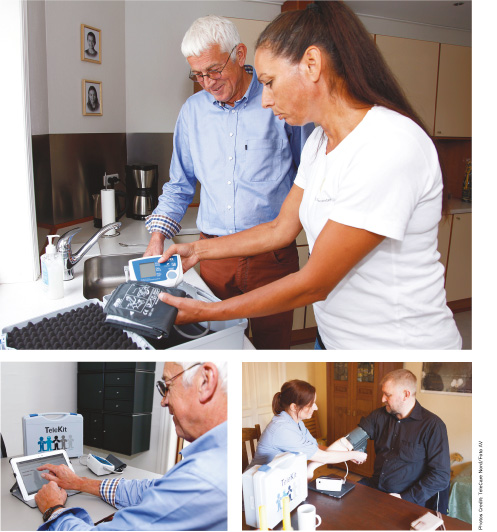HealthManagement, Volume 17 - Issue 2, 2017
Since its introduction into the Danish healthcare landscape, telehealth has shown that it can lead to better outcomes and reduced costs. Hans Erik Henriksen, of Healthcare Denmark, writes about the difference telehealth has made to the senior population in recent years.
Over recent years, Denmark has conducted a number of telehealth pilot projects, which has given them the knowledge to launch three largescale telehealth projects. The purpose was to establish a region wide, full implementation of telehealth to support Chronic Obstructive Pulmonary Disease (COPD ) patients. From the start, the large-scale telehealth projects were analysed by more than four parallel research projects to not only implement telehealth, but also build the evidence for nationwide adoption. The research projects prove not only that substantial savings are possible with telehealth, but also that telehealth can improve patients’ Quality Adjusted Life Years (QUALY) and their general quality of life.
Denmark – an eHealth Society
The introduction of IT in the Danish Health sector started in the 1970s when the first Patient Administration Systems (PAS) were introduced. During the 1990s Electronic Health Records (EHR ) and Electronic Medical Records (EMR) systems started to emerge and this was the basis for the organisation MedCom, established in 1994, with the single mission to create a nationwide Health Data Network.
During the next decade, different Healthcare IT -strategies drove the adoption of IT in the Danish Healthcare sector – starting out with targets for full implementation of EHR in hospitals and continuing with targets for communication and IT adoption in other parts of the Danish Healthcare Sector.
By 2002 the MedCom Health Data Network was almost complete, i.e. most prescriptions, referrals, discharge letters, laboratory results and reimbursements were handled electronically. At the same time, driven by the Health IT -strategies and by MedCom, a high level of EMR adoption at General Practitioners (GP) and specialists had been achieved, and hospitals had either implemented EHR ’s or they were planning implementation projects.
Interchangeable electronic healthcare data at a national level was the inspiration for establishing the National eHealth Portal (sundhed.dk), which went live in 2003.
Today, all Danish citizens can securely access their healthcare information through sundhed.dk. This includes their medical history, (dating back to 1977), all medicine and drug information, lab results, referrals and clinical notes. Protected by the security system, the same information is available to clinical professionals, when they are treating the individual patient.
Today, electronic sharing of Healthcare data in Denmark is handled through a national architecture, which makes it possible to pull and push data from a variety of different regional or local solutions (i.e. EMR, EHR , HIS , pharmacy) to a national repository – The National Service Platform. The National Service Platform holds the repositories and data, which patients and clinical professionals share, through sundhed.dk., but Healthcare Regions and Municipalities can also access and share data from the National Service Platform through their local systems.
For years, Denmark has been among the countries with the highest Internet penetration and, alongside the eHealth journey, general strategies for digitalisation (eGovernment) have been implemented. In November 2014 public authorities in Denmark switched to electronic service and Danish citizens no longer receive paper letters from any public authority – instead all communication (and most services) are handled through the internet.
In conclusion Danish citizens are now used to public eServices and eHealth – and this is a perfect start point for the next steps towards nationwide telehealth.
See Also: Health IT: Benefits to Both Patients and Providers

Telehealth
One of the main objectives of the Danish healthcare IT-strategy 2014-2020 is to advance and up-scale the use of telehealth to
empower, educate and involve chronic patients in managing their own disease.
Following
a decision taken in 2012, Denmark was the first country to adopt national
standards for interoperability of personal health technologies based on the Continua
Health Alliance. The Danish telehealth architecture also involves using the
Health Level 7 Personal Health Monitoring Report (HL/7 PH MR) standard to further
document telehealth device readings.
Danish Healthcare Regions are in the process of up-scaling
the implementation of telehealth in close cooperation with Danish
Municipalities.
In the North Region the project, TeleCare North, was
established in 2011 and has rolled out telehealth support to approx. 1,300 COPD
patients. Since then, large research programmes have monitored and analysed the
effects and benefits of telehealth, in order to build the evidence for a
national rollout.
The TeleCare North Project
In the TeleCare North project, The North Denmark Region, the 11 associated municipalities, Aalborg University and local doctors cooperated to enrol all patients with the lung disease, COPD , in the telehealth project.
The participants in the project received a TeleKit, which gave patients the opportunity to measure and report data about their condition by themselves. The virtual contact was supported by physical visits either at home or the hospital.
Benefits for Both Patients and Public Spending
The patients
in the TeleCare North project reported a very positive experience. Six in ten
experienced increased control of the disease, while more than seven in ten
experienced increased comfort and mastery of their disease. Usability is key
for the success of telehealth, and the patients’ feedback on the TeleKit was positive.
A random sample made during the TeleCare North project showed how almost ninety
percent thought it was easy or very easy to use the TeleKit.
In The North
Denmark Region alone, 45,000 citizens are diagnosed with COPD , and it is
estimated that around ten percent of these COPD patients are characterised as
severe or very severe. Figures from the Danish Lung Association estimate that
around 23,000 COPD hospitalisations are made annually throughout Denmark.
Hence, the economic potential is significant if telehealth leads to fewer
hospitalisations.
Telehealth Evidence
The TeleCare North project proved that telehealth support
provides the highest benefits for COPD patients in the GOLD 3 and GOLD 4
categories, ie patients with severe or very severe COPD . Patients in GOLD 3
(severe COPD ) achieved the highest benefits.
For both patient categories, the
researchers who followed the project documented that the patients quality of
life, as telehealth patients, improved because of the increased education and
insights in living with their chronic disease. Also documented was that the ability
to participate and be active in controlling their own disease was an important
factor in both quality of life improvements and in reducing the number of admittances
to hospital.
Can Danish health authorities save money and at the same time achieve the above-mentioned effects - improving the patients quality of life and QUALY? This was the key question to be answered to enable a decision to be taken to implement telehealth on a national scale.
The result of the financial analysis is that the payback time for investing in national implementation of telehealth in Denmark, to support all COPD patients in the GOLD 3 and 4 target groups, would be two to three years. This is based on three different scenarios, where the likely scenario indicates an annual investment/savings of 1:3 (i.e. every time one euro is invested, it generates a saving of three euros). The best-case scenario indicates a savings/investment ratio of 1:4 and the most conservative scenario a ratio of 1:2.75.
The large-scale telehealth projects for COPD patients have proved the case for telehealth as a means of reducing hospital admittances, reducing costs and improving the quality of life for patients. This has been fundamental in Denmark’s decision to implement telehealth at a national level, starting out with the target of implementing national telehealth support for all Danish COPD patients before the end of 2019.
The large-scale telehealth projects also resulted in new ways of working and organising telehealth support between the regions, hospitals, municipalities and primary care services. These results and experiences are helping the regions to take the next steps towards regional implementation of telehealth support for other chronic patient categories like diabetes and heart disease patients.
















